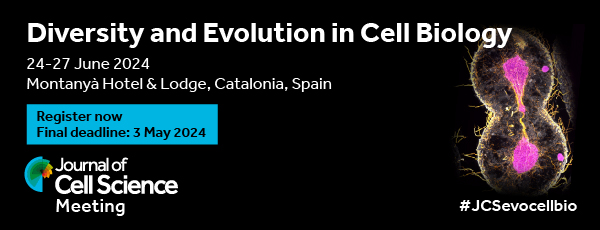Issues
-
Cover image
Cover Image

Cover: Live cells of the green algae P. margaritaceum treated with the callose-deposition inhibitor Endosidin 7 (ES7) followed by sequential immunolabelling with the pectin cell-wall antibody (JIM5). ES7-treated cells first labelled with JIM5 (green). After ES7 removal, pectin cell walls were re-labelled with JIM5 (magenta). This sequential pectin labelling revealed some cells with irreversible cytokinesis defects and aberrant JIM5-pectin deposition in the isthmus zone (see non-separated cell in the centre) and some recovered cells showing the typical JIM5-negative isthmus band (see cells at bottom left), demonstrating an essential role for callose deposition during cytokinesis in P. margaritaceum. See article by D. J. Davis et al. (jcs249599).
- PDF Icon PDF LinkTable of contents
- PDF Icon PDF LinkIssue info
RESEARCH HIGHLIGHTS
STICKY WICKETS
FIRST PERSON
OPINION
Molecular basis for KDEL-mediated retrieval of escaped ER-resident proteins – SWEET talking the COPs
Summary: The structure of the KDEL receptor gives new insights into the close connection between trafficking and transport in the cell.
REVIEW
Ras, PI3K and mTORC2 – three's a crowd?
Summary: Current evidence suggests conserved but separate roles of Ras and PI3K in the direct activation of mTORC2, implicating the regulation of distinct cellular mTORC2 pools downstream of different stimuli.
RESEARCH ARTICLES
Callose deposition is essential for the completion of cytokinesis in the unicellular alga Penium margaritaceum
Highlighted Article: Callose deposition during cytokinesis is important for cell wall formation. There is a conserved role for callose at the division plane between P. margaritaceum, a unicellular Charophyte, and land plants.
Integration of JAK/STAT receptor–ligand trafficking, signalling and gene expression in Drosophila melanogaster cells
Highlighted Article: Compartmentalised signalling along the endocytic pathway regulates expression of JAK/STAT targets. This suggests a mechanism by which a single ligand can give rise to different signalling outputs.
Topical insulin application accelerates diabetic wound healing by promoting anti-inflammatory macrophage polarization
Summary: Overexpression of insulin-degrading enzyme leads to low insulin levels in diabetic wounds, resulting in dysfunction of neutrophils and macrophages. Supplying insulin promotes wound healing by inducing anti-inflammatory macrophage polarization.
Cargo-mediated recruitment of the endocytic adaptor protein Sla1 in S. cerevisiae
Highlighted Article: Cooperation between cargo binding and interaction with other endocytic coat proteins is essential for adaptor protein recruitment to the membrane.
Regulation of caveolae through cholesterol-depletion-dependent tubulation mediated by PACSIN2
Highlighted Article: Regulation of caveolae by the F-BAR protein PACSIN2 is dependent on the plasma membrane cholesterol level.
The F1 loop of the talin head domain acts as a gatekeeper in integrin activation and clustering
Summary: Direct interactions of the acidic F1 loop motif of talin with the juxtamembrane domains of integrin activate the β3 integrin heterodimer.
Invariant chain regulates endosomal fusion and maturation through an interaction with the SNARE Vti1b
Summary: Invariant chain (CD74) interacts with the SNARE Vti1b. This interaction is essential for invariant chain to delay endosomal maturation, thereby creating a pathway for slower antigen processing and antigen loading.
Amalgam regulates the receptor tyrosine kinase pathway through Sprouty in glial cell development in the Drosophila larval brain
Highlighted Article: Employing single-cell RNA-seq uncovered that Amalgam affects receptor tyrosine kinase signaling and the blood–brain barrier during glia development and in a glioma model in Drosophila.
The centriole protein CEP76 negatively regulates PLK1 activity in the cytoplasm for proper mitotic progression
Summary: The centriole protein CEP76 is essential for the proper regulation of PLK1 in the cytoplasm to prevent its aberrant activation during mitosis.
Introducing our new Editors

We welcome three new Editors to Journal of Cell Science - Robert Parton, Richa Rikhy and Simon Cook. You can read more about them in the Editorial from our Editor-in-Chief Michael Way.
2024 Journal Meeting 'Diversity and Evolution in Cell Biology'

Registration is open for our 2024 Journal Meeting Diversity and Evolution in Cell Biology, which aims to bring together evolutionary biologists and cell biologists investigating diverse aspects of cellular physiology. Final registration deadline: 3 May 2024.
Workshop: Physics of the Early Embryonic Cell Divisions

Early-career researchers interested in the roles of nuclear lipids, apply now for one of the ten funded places at this Workshop, which will take place 11-14 November 2024. Application deadline: 17 May.
Reasons to submit to Journal of Cell Science

There are many benefits to publishing in Journal of Cell Science - read more about why you should choose JCS or visit our submission page now.
Propose a new Workshop for 2026

We are now accepting proposals for our 2026 Workshops programme. We aim to be responsive to the community and open to novel initiatives, so if you have a new idea for a biological workshop that you feel would work well, please apply. Applications deadline: 19 July 2024.



